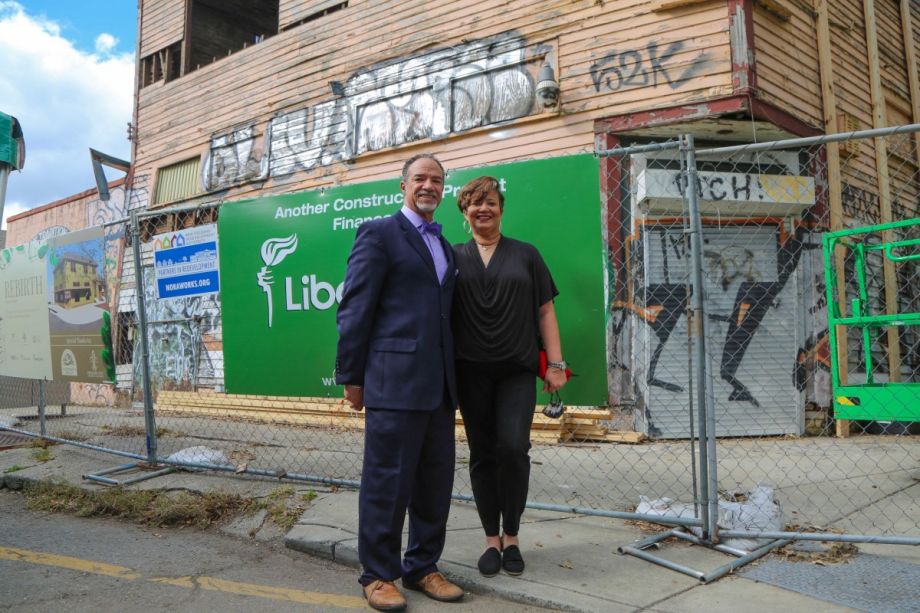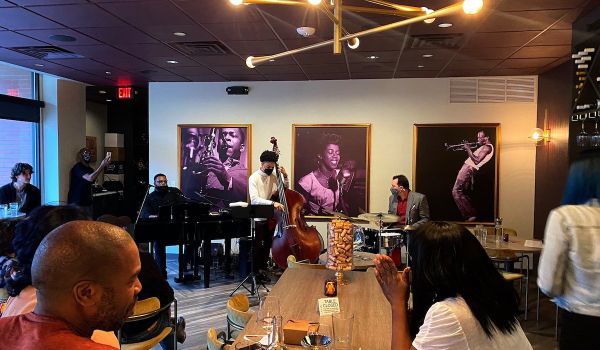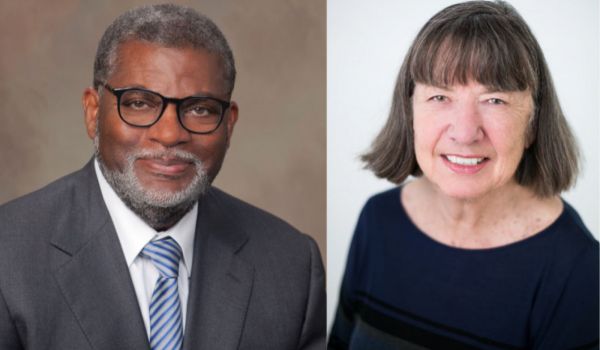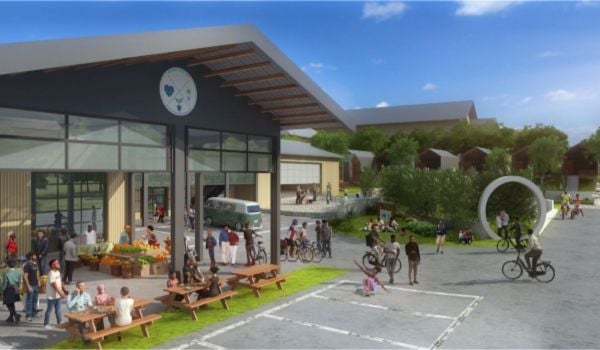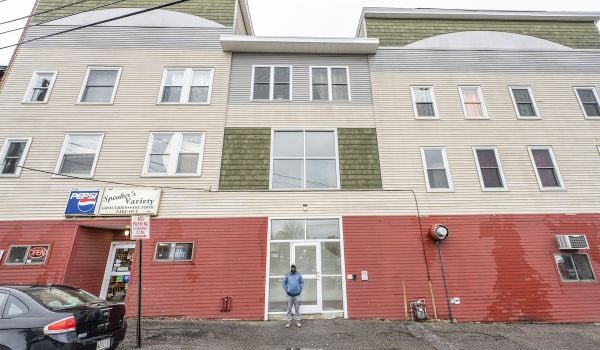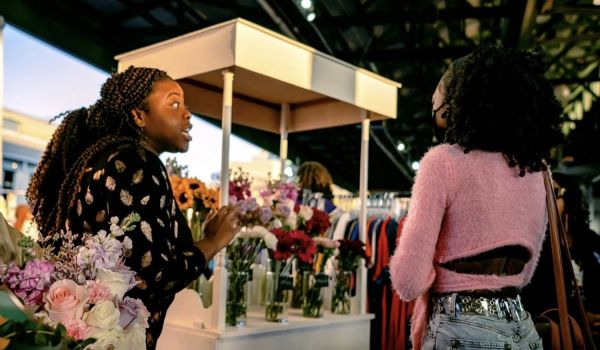If you’ve been one of 300,000 annual attendees at the New Orleans Jazz and Heritage Festival over the past decade or so, chances are you’ve heard Vance Vaucresson “barking,” — hawking his wares, in his case the famous Vaucresson Sausage. You may have been lucky enough to catch Vaucresson, also a jazz vocalist, performing the jingle he wrote about it.
And when folks take a sample, Vaucresson knows the product seals the deal just about every time. “For that little piece of sausage that might cost me ten cents, I’m making an $8 sale,” he says.
The founders of the New Orleans Jazz and Heritage Festival knew from the very beginning that food vendors had to be a part of the experience. The first vendor they invited was Vance’s father, Robert “Sonny” Vaucresson, the co-owner of Vaucresson’s Creole Cafe, the first Black-owned business on the city’s famous Bourbon Street. They were meeting at Vaucresson’s to brainstorm about the first festival, which took place in 1970.
Sonny Vaucresson sold the restaurant after nearly a decade. But, a bit of a gambler, he bought a corner building at 1800 St. Bernard Avenue, in New Orleans’ 7th Ward, and in 1983 he converted it into a sausage factory even before he had any clients. He did have a name to build from because his father, Robert Levinsky Vaucresson, had been a butcher serving the 7th Ward since 1899, getting his start as a vendor at what was then the St. Bernard Public Market.
Vaucresson Sausage would eventually come to be sold widely in local grocery stores, procured by local restaurateurs, and even served in the local public school system. The day before the business made its first direct delivery to public schools, in 1998, Sonny Vaucresson passed away, leaving the business in his son’s hands.
After Katrina wiped out the Vaucresson Sausage factory, the younger Vaucresson lost his primary source of income. When the festival resumed in 2007, he brokered a partnership with a local competitor to use their facility to produce his family’s famous sausage. Vaucresson has since expanded to other festivals, keeping the product name and reputation alive.
Meanwhile, Vaucresson has also been trying to revive the former sausage factory site. But over the past decade, Vaucresson has had one potential development partner unexpectedly die, and another broke a handshake promise to work with him on his site after working with him to advance a major affordable housing project across the street.
It took another child of the 7th Ward to finally make it happen. In December 2020, Vaucresson broke ground on the revitalization of the former Vaucresson Sausage Factory, with a plan to convert it into a sausage market and sit-down restaurant with a bar on the first floor and two permanently affordable apartments above. It won’t be a full factory because the building is too small to qualify under today’s USDA guidelines, but the current plan is to build the restaurant space around a central butcher station where Vaucresson can make sausage while he sings and talks about the history of the neighborhood. The co-developer on the project is Crescent City Community Land Trust, led by executive director Julius Kimbrough.
“I’ve been walking through this neighborhood my whole life, he’s been walking through this neighborhood his whole life. My father used to operate a pharmacy six blocks from where Vance’s father operated his meat production facility,” says Kimbrough. “They knew one another and crossed paths, but we as children never met. I knew his family name and he knew my family.”
Community Land Trusts are mostly known as a solution to produce permanently affordable housing. Most affordable housing produced across the country comes with an expiration date — after a certain point, the private developers who got a public subsidy to build units reserved for low-to-moderate income families can raise rents to market rate or sell the building, which can lead to a wave of evictions. It’s particularly feared in New Orleans because so much affordable housing was built around the same time, as the city recovered from Hurricane Katrina. Those expiration dates are already starting to come up, and it’s leading to tenants’ worst fears.
As a solution, a community land trust buys land while selling or renting the homes above to residents. Separating the land ownership from the structure on top reduces the amount of financing needed to buy a home, while also pulling the land itself out of the market, where it can fuel dangerous speculation — like what happened in the run-up to the financial crisis of 2007-2009.
There are an estimated 225 community land trusts active around the U.S., representing some 20,000 rental units and 15,000 homeownership units, according to Fannie Mae, the mortgage giant, which does finance mortgages for homeowners on community land trusts.
In addition to their real estate mechanics, community land trusts are also seen as vehicles for community power in real estate and development. It’s a standard practice for community land trust board members to include representatives of residents on the land trust, residents of the surrounding community, and trusted professionals with relevant backgrounds real estate lawyers, accountants, local developers or contractors. Some believe this governance structure can make community land trusts too slow to be successful in real estate, or challenging to work with as business partners.
There is commercial space among some other community land trusts, but it’s mostly been accidental or peripheral to the focus on housing.
Cooper Square Community Land Trust was until recently the only operating land trust in New York City. The land trust’s roots and focus have always been in residential tenant organizing and resistance to bulldozing the neighborhood in favor of Robert Moses-led Urban Renewal plans. It has 21 buildings with 328 residential units scattered across a few blocks of Manhattan’s East Village. But Manhattan is covered in mixed-use buildings, so Cooper Square Community Land Trust also happens to include 24 storefronts, whose rents generate more than a quarter of the land trust’s income.
Oakland Community Land Trust started out focusing on acquiring distressed or foreclosed homes in the wake of the financial crisis and preserving them as affordable, preferably for low- or moderate-income families who were already living in them. But over the past two years, Oakland Community Land Trust has acquired not one but two primarily commercial properties in partnership with commercial tenants at risk of being displaced by higher rents.
In Minneapolis and Pittsburgh, commercial community land trusts are emerging as part of broader efforts to revitalize historically Black commercial corridors.
Crescent City Community Land Trust has some typical residential properties in its portfolio, in the city’s Lower 9th Ward, but its pipeline of nine projects also includes The Pythian, a historic building in downtown New Orleans with 69 apartments (25 of which are permanently affordable) above a ground-floor food hall and more commercial space.
“When we talk about the CLT model to African Americans we have to be cognizant of the history of African Americans in this country,” says Kimbrough. “They’re thinking about redlining, they’re thinking about situations where African Americans have historically been deprived of the opportunity to gather capital, save capital, invest in real estate or own real estate. And that’s a very reasonable question. So we have come up with answers to those questions about why the model is applicable to African Americans and valuable to African Americans, why it’s important to create commercial spaces serving low- and moderate-income people for perpetuity in these gentrifying neighborhoods beyond affordable homeownership.”
For Crescent City Community Land Trust, protecting and advancing Black entrepreneurs and Black-owned businesses is a key component of preserving culture in New Orleans, a city that depends heavily on Black and indigenous culture to drive its main industry, tourism. The former sausage factory is just steps from the French Quarter, and despite the painful history of ramming highways through Black neighborhoods, including in this neighborhood, today there’s an offramp from the highway convenient to this location.
“We have this vision in our head of like a Coldstone Creamery for sausage where you get the story behind the food and a little show, with a little butcher station in the center of the restaurant area,” says Kimbrough. “He will be able to tout our culture while he’s talking about the product, and produce sausage the way it was historically produced at a very small scale.”
With its Black leadership and its focus beyond housing, Crescent City actually reflects the roots of the community land trust movement. The first community land trust in the country was New Communities Inc., organized by Black farmers to acquire and cultivate land near Albany, Georgia. It was about permanent economic self-determination, in addition to permanent ownership of the land.
“The community land trust model is again showing up the same way it showed up in Albany to provide Black people the opportunity to become self-sufficient, and to retain ownership of land,” says Nathaniel Smith, founder and chief equity officer of the Partnership for Southern Equity, based in Atlanta. Smith also serves on the board of Grounded Solutions, a national network of community land trusts and inclusionary housing advocates.
“We’re valuable regardless of what we own, but it is true that America was built on the idea of ownership, on land ownership,” Smith says. “You have a nation built on stolen land, cultivated by stolen labor, so to change that relationship for those same people who worked on that land to share ownership in that land in a way that is affordable, and also protected and maintained regardless of what happens to the market, is just a wonderful thing.”
Even for those relatively rare cases where Black families like Vaucresson’s have managed to hold onto land and buildings, the relative lack of liquid wealth among Black communities — meaning cash, or stocks and other investments that can be sold off easily — means that they have less “friends and family” wealth to call upon, leaving them more dependent than others on external debt to fund new businesses or major projects like revamping a 3,000-square foot former sausage factory into a restaurant with two permanently affordable apartments above.
It was the land trust that finally took the time to partner with Vaucresson and put in the resources to help put a plan together that made sense to larger funders. Vaucresson had previously come up with two possible scenarios for the former sausage factory and pitched them to the New Orleans Redevelopment Authority and the Louisiana Office of Community Development. Although both were open to funding something for the site, neither bit.
“[The redevelopment authority] was sold on it from the beginning, they were just like you gotta get your numbers right,” Vaucresson says. “The state said it fit their mission at the time, just gotta get your numbers right.”
The land trust has invested $150,000 so far to buy a share of ownership in the property, and those funds have ended up paying for architectural and other preliminary work to come up with a proposal that would pass muster — sausage-making to protect a former sausage factory. It took two years, but according to Kimbrough, the project finally got a collection of long-term, low-interest loans from NORA, the City of New Orleans and the state’s Office of Community Development, which the project is combining with Historic Preservation Tax Credits for a total of $2.1 million in development costs.
“Julius [Kimbrough] was the conduit,” says Vaucresson. “he is the true crafter, the ‘Merlin the magician’ in making this all happen.”
There was one more piece of funding needed. The NORA, city, and state loans don’t give the money up front. Borrowers have to spend the money and submit invoices, receipts and other documentation to verify the money was spent on work that actually happened. It’s meant to prevent fraud and waste. So some banks and other construction lenders have come to specialize in financing the up-front costs for projects like these.
Against the advice of many others around them, Vaucresson and Crescent City Community Land Trust insisted on getting their upfront financing from Liberty Bank and Trust, the only Black-owned bank in New Orleans. Kimbrough worked there for eleven years, eight of them post-Katrina. Liberty used to have a branch a few blocks from the site.
“My dad had done business with them since 1974, he was one of the earliest business depositors,” says Vaucresson. “Been working with them ever since. Done mortgages for us on other properties. Everybody was like don’t do it with them, don’t do it. I was like why? Because that’s just the perception of doing business with a Black bank. But I said if I’m going to have a Black business how hypocritical would I be to not give that opportunity to a Black bank.”
That said, all banks, even community banks and even Black-owned banks have a tendency to be conservative by default — there’s always a lingering fear, warranted or not, that bank regulators will view certain investments as riskier than they really might be, leading to negative consequences for the bank down the line.
“But I knew what I needed to do with them having done business with them for so long,” Vaucresson continues. “I said let’s go get some other term sheets from other people. So we got two other term sheets, from a bank and a [community development financial institution], and I presented it to them. I said look this is what’s on the table. I’m not begging you for shit. Can you match it? If you want the business you can match it or I’ma go elsewhere. And they were like no, we want to do it.”
EDITOR’S NOTE: We’ve corrected Nathaniel Smith’s title.
This article is part of The Bottom Line, a series exploring scalable solutions for problems related to affordability, inclusive economic growth and access to capital. Click here to subscribe to our Bottom Line newsletter.

Oscar is Next City's senior economic justice correspondent. He previously served as Next City’s editor from 2018-2019, and was a Next City Equitable Cities Fellow from 2015-2016. Since 2011, Oscar has covered community development finance, community banking, impact investing, economic development, housing and more for media outlets such as Shelterforce, B Magazine, Impact Alpha and Fast Company.
Follow Oscar .(JavaScript must be enabled to view this email address)



